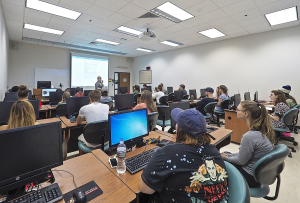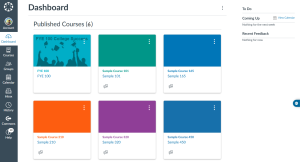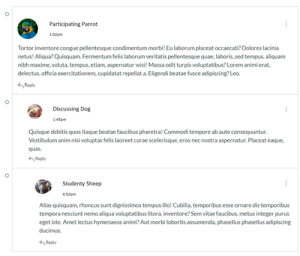5.1: Distance Education
Stevy Scarbrough
Learning Objectives
Upon completion of this reading, you will be able to:
- Identify common assumptions about online learning.
- Compare the pros and cons of online learning.
- Describe different modalities for course delivery in online education.
- Describe different technologies used in online education.
- Compare and contrast asynchronous and synchronous communication in online learning environments.
In November 2001, an exciting $700 million-dollar project began in Oklahoma City, Oklahoma: The public school system would be modernized and upgraded. Part of the renovation would take place in Emerson School, a 120-year-old building—one of the first public schools built in the city. Slated to be removed and replaced with Smart Boards where four old, green chalkboards still hung on several classroom walls.
When the contractors removed the green chalkboards, though, they made an amazing discovery: they found a set of blackboards hanging behind the green chalkboards that contained writings and drawing of students and teachers in 1917. On one board, for instance, were notes in a treble clef, apparently from a music class. On another blackboard were illustrations of Thanksgiving pilgrims. On still another was a multiplication wheel—a teaching device of yesteryear that the then-current school employees did not understand. The renovators also found old report cards, as well as a newspaper clipping advertising “Women’s shoes, $3.00!”
Teacher Sherry Read reflected on the meaning of this discovery: “I think they [the teachers in 1917] left them there on purpose to send a message to us, to say, ‘This is what was going on in our time.’”
Today, the formerly hidden chalkboards are protected with acrylic glass. Controls are also in place for light and temperature exposure. With this care, the chalkboards could last another one hundred years. To see photographs of the find, visit Oklahoma’s Hidden Chalkboards of Yesteryear.

Indeed, 1917 was another era of classroom teaching. Just imagine if the students and teachers from that day were to visit your college classrooms today. How much culture shock would they experience? Do you think they would be able to catch on to your level of technology skill and awareness?
Clearly, the technological differences between 1917 and now are staggering. Today we have online classes, blended learning, and flipped classrooms, MOOCs, micro-lectures, and mobile learning. We have blogs, wikis, podcasts, clickers, cloud computing, virtual reality, and gaming. And we have laptops, tablets, smartphones, 3D printing, eye tracking, and LCD touch boards.

Online learning has become increasingly more popular over the last decade. Students are looking to take courses online at an ever-increasing rate. With the increase in part-time studies and students juggling many things including classes, jobs, families and hobbies, taking traditional scheduled classes becomes increasingly harder. There are many advantages to online learning as well as many potential disadvantages. It is important to consider whether online learning is a good option for you. There are several misconceptions about online learning. Many people think that online means it will be easy. Or they believe that since it’s online they won’t have time management issues. This is usually not the case.
Common Assumptions About Online Learning
If you have taken an online course before, you may know if it is right for you. If you haven’t, it is a good idea to consider the pros and cons of learning online, before signing up. One of the mistakes that people often make when deciding to take an online course is about the assumptions they have made regarding learning online. They may have taken or heard of an online course and assumed that all online courses work the same way. Here are the most common assumptions that people have about learning online:
- Assuming you can take as long as you like to complete a course
- Assuming you can fit it into your already busy schedule because there aren’t scheduled classes to attend
- Assuming that online means that there are no class caps
- Assuming that you can start anytime
- Assuming there are no face-to-face components or scheduled online time commitments
- Assuming that online courses are as portable as a laptop and a Wi-Fi connection
- Assuming that online isn’t as much work
Although these assumptions are sometimes true, often they are not. Online courses can be structured very differently from each other. You will need to find out about the structure of the course you want to take when deciding if it is right for you. Here are some things you will want to consider.
Completion time
Most courses have a completion deadline, such as a 16 week semester or 10-12 week quarter term. For some courses the deadline only entails a date by which the whole course must be completed by. It doesn’t matter if you spread it out evenly or cram it all in at the end (though not a recommended study skills strategy) as long as it is completed before the deadline. However, other online courses have strict deadlines throughout the course. For example, the course might have a regular schedule where assignments are due every Friday, forum posts need to be made throughout the week, and specific tests are scheduled throughout the term. Don’t get caught making assumptions, and check out the schedule for the course you want to take. Make sure it is doable for you.
Busy schedules
Many people think that just because there are no scheduled classes that they will be able to fit in their studies in all their free time. Many students overestimate how much free time they have and are panicked when they realize that only a few weeks into the course they are already very behind. Many post-secondary courses require dedicating between nine to twelve hours per week per course on readings, lectures, videos, activities, assignments, exams, etc.. Look at a typical week’s schedule and mark in your commitments such as your job, volunteer commitments, and family responsibilities. Schedule where you will work on your course. If you can’t carve out nine to twelve hours per week regularly, you may not have the time to do the course, or you may have to give things up to make the time.
Class caps
For some, their experience with online courses includes short certification courses such as Serving it Right or FoodSafe. These courses can be taken online, and the tests are multiple choice so people can get their results instantly. The whole test is automated. People mistakenly assume that all online courses are like that and, as a result, think they can sign up anytime and that unlimited numbers of people can take the course at a time. Post-secondary courses offered online are rarely like that. They have instructors who mark your assignments, give individual feedback, and are available for help. Courses include class discussions and forum posts, and they have many of the components of a face-to-face class. As a result, instructors cannot have limitless people in their online classes, and institutions have class caps (maximum class sizes) for online courses just as they do for face-to-face courses. Online courses fill up and have wait lists just like traditional classes. Don’t assume you can sign up for your course anytime. Register early to ensure a “seat” in the class.
Start dates
Another common misunderstanding about online courses is that people assume they can start anytime. Some post-secondary institutions, such as Open Learning-Thompson Rivers University, are generally structured that way and have continuous intake, however many are not. They have term start dates just like face-to-face classes. Make sure you are reviewing your college’s academic calendar each term so that you know when the 1st day of your online (as well as face-to-face) courses begin.
Portability
Often online learning conjures up the image of traveling around with a laptop, light and easy, knowing that all your learning material is digital. This is often not the case. Just because the course is online doesn’t mean that everything you’ll need is online. There are often a stack of textbooks, lab equipment, journal articles, and manipulatives that accompany an online course. Sometimes online courses are not as portable as you would expect.
Nice and Easy
Another assumption is that an online class will be easy. This also is rarely true. In fact, it can pose challenges for some learners. Instead of being able to listen to a lecture, students may have much more reading to do. This can be more time consuming for some learners. If students are working in isolation, it can take more time just figuring out what is required rather than having classmates to discuss things with. (However, many online courses have chat rooms for classmates to discuss these kinds of issues.) Thoughtfully crafting forum posts (the online version of a class discussion) to add to online discussions can be far more time-consuming than just adding to a verbal discussion in class. Online courses are rarely easier than their face-to-face counterparts, however, they do often save time in other ways, such as travelling to and from class, so it can work itself out.
Here are some typical questions to research answers for when considering an online course.
- What are the course start dates? Is it continuous intake, or are there specified start dates?
- Are there structured due dates for course activities and assignments or is it self-paced?
- How long do I have to complete the course?
- What happens if I don’t complete the course in time
- What are the office hours or times of availability for instructor help?
Asking these questions will help you avoid falling into the trap of making typical assumptions.
Pros of Online Learning
As you evaluate whether or not online learning is a good fit for you, it helps to consider the pros and cons. Some of these pros and cons will be more important to you than others, depending on your situation, so it’s important to consider your own specific circumstances and your learning strengths and weaknesses. Here are a few benefits to consider:
Schedule flexibility
Increasingly, students have complicated schedules, often juggling several part-time jobs, family responsibilities, and other commitments. For many, education has been out of reach when traditional scheduled classes did not mesh with their busy schedules and obligations. Online learning means students can learn when it suits them. Students can do their readings throughout the day in between other commitments. They can work on and submit assignments in the middle of the night if that suits them. The time flexibility literally means that students who just couldn’t take classes on a traditional schedule can now further their education on a flexible schedule according to their needs.
Location flexibility
Online learning also opens up education for people who live in areas that do not have post-secondary institutions, especially remote communities. People can study at home or in local libraries or in convenient locations that eliminate the need to commute to physical institutions. This can save students hours of daily commuting time. It can also save students substantial amounts of money if it means they do not have to relocate to attend school. This is a significant factor for many who have financial concerns, housing concerns, or have a family member who cannot relocate due to employment or other obligations. Even people in big cities that do have post-secondary institutions welcome the opportunity to forgo a long commute to and from a college or university numerous times a week.
Multi-media
Learning happens more efficiently when several modalities are engaged. It helps to see (read or watch), hear (lecture or demonstration), do (labs, practice a skill, or write), as well as practice. Often people think that learning online will restrict learning because they’ll have to read everything. The opposite is actually true. With so many options for multi-media, modalities can be fully engaged through online learning. Courses can include video clips, lab demonstrations, and virtual labs where students can dissect something over and over until they’ve got it (as opposed to having one crack at it for an actual dissection). Courses can include hyperactive web links which can conveniently direct you to websites, web articles, and web demonstrations that add fascinating content. Courses can include high quality diagrams, graphs, interactive demonstrations, video podcasts, animations, Ted-Talks, YouTube clips, interactive digital learning games, blogs, wikis, learning objects, virtual worlds, and much more. Edutainment is a term describing applications that incorporate multimedia entertainment with educational objectives. Quality online courses have an array of possibilities that can keep the curriculum current and engaging.
Classmates
Online learning offers a diversity in classmates that often exceeds that of a face-to-face class. As you get to know your classmates through class discussions, online forums, group work, and class presentations, you will often meet people from all over the world. This allows for some interesting perspectives and a more global way of thinking and interpreting information.
Course selection
Making the decision to learn online means that there are seemingly limitless options in course selection. You have the option of enrolling in a different college than the one you would have chosen if you had to move there. It doesn’t matter how far away it is if you are learning online. You can choose courses according to price, convenience, and interesting topics. Often you do not necessarily have to take all your courses from one institution if there are courses elsewhere that interest you. If you are taking courses from more than one institution, just be sure to check out transferability into the program you are enrolled in or want to graduate from, prior to taking a course from elsewhere so you do not lose credit for the course.
Financial
Tuition and books are often priced the same for online and face-to-face courses, however, there are financial considerations that can make online learning more affordable. Firstly, the flexibility of online means you may not need to quit your job, since you can work on coursework around work hours. (Be cautious that you don’t work so much that you don’t have time for your courses, though.) Having an income while going to school can relieve a great amount of financial burden and reduce accumulation of student loans. Secondly, you will not have extra accommodation fees or relocation costs taking online courses since you will not have to move to go to school. Even if the college or university is local, you won’t have transportation costs including public transit costs or gas and parking fees to travel to and from the institution. If you are a parent, you will likely have less child-care costs. You can also save money, since students are likely to eat out more when traveling to a campus.
Combination of online and face-to-face
It can be an option to do some of your courses face-to-face and some online. This can cut down on commutes if you choose to do online courses on certain days and work your schedule accordingly. This strategy can take advantage of the pros of both. It can also allow you to get to know instructors from a program in person during your face-to-face classes, giving you a personal connection with them for your online classes. Another use for combining formats is to take missing prerequisites online so that you don’t miss an opportunity to take a course according to your education plan. This can often save you from having to add an extra year to your education. Another pro of combining formats is that you can choose to take electives for your program online in the summer months, to get ahead on your education plan, or to lighten the load in the regular school year. There can be many advantages of taking a combination of online and face-to-face courses.
Cons on Online Learning
Time management
You have to be very organized when you take courses online. It is entirely up to you to stay on-track. Although this is true in a face-to-face class as well, students often feel more pressure when they have scheduled classes. They don’t want to miss class or get behind. They have classmates around them talking about upcoming assignments and tests, who inadvertently pressure them into getting things done. When they know they have class Monday morning, for example, they make sure they complete the course work that is required before that class. These scheduled things are more conducive to keeping on track. Online students are notorious for procrastinating and getting behind. It is vital to keep a schedule as if you were attending face-to-face classes. Once your study times are in your schedule, don’t divert from the schedule unless it is critically important. (That doesn’t include that your friend called you up and asked you to go to the show!) You have to get used to telling people you are busy with your school work and that you are not available. We will review time management strategies in our next chapter (chapter 4).
Motivation
Motivation is another key factor for success in online learning. If you are constantly talking yourself out of doing assignments, doubting your abilities, or not willing to give it your all, this can seriously impede your ability to be successful. Some people know themselves and are aware that they don’t have the motivation, self-drive, and determination to be consistent in their online studies. They will make the sacrifices required to commit to face-to-face courses. In other words, they are willing to commute and change their schedules to accommodate their scheduled classes, because they know that, for them personally, they are likely to be more successful in their courses.
Heavy Reading Component
Online learning most often involves a lot of reading. Some learners are strong readers and find they learn more by reading than listening in a class. Others find reading tedious and lose focus. If reading is a struggle, you may want to find out the differences in the amount of reading between the specific face-to-face classes and the online classes you are interested in taking. This may have a bearing on which format you choose.
Heavily Reliant on Computer Skills and Technology
Those who have very little experience with computers will find it more challenging doing online courses. As well as learning the course material and expectations of the instructor, these people will have to deal with learning computer skills concurrently. This is not necessarily a con as they will benefit greatly, however, it would be important to allow extra time needed for dealing with the learning curve of gaining the necessary computer skills. Of course, taking a face-to-face course likely will require computer skills as well, so it is wise to gain them regardless. Likely, it will initially be a little more challenging with an online course. Prior to starting online courses, it would be beneficial to take a computer skills course at a local community college, if possible.
Limited Social Contact
Some learners enjoy the dynamics of being in a physical classroom. They get to form a personal relationship with the instructor. They meet classmates in person and can form study groups. They can benefit from the answers to questions that others ask or from the class discussions that arise. After class, they can easily discuss issues that they didn’t understand or they can go deeper into an issue, furthering understanding. Even moral support is a beneficial perk of having face-to-face classes. Other classmates can detect whether or not you are struggling and can offer support, lend materials, and offer a much needed smile. Many people really appreciate the social aspect of attending classes and being part of a college or university where they can join teams and clubs, have a drink at the campus pub, live in residence, and develop a healthy social life. This is particularly important for young students who have recently left home after completing high school. Older students who already have children and jobs, may not necessarily be looking to expand their social lives.
The format of some online courses are specifically designed to include a social aspect to learning. The course incorporates group assignments and forum discussions. Students get to know each other even though they may all be in different locales. Other courses don’t have any social component to them. Often in these online courses, students can feel very alone as they do their courses. If the social aspect is important to you, find out how the courses are structured at the institution where you are considering taking your program.
Online Learning Classroom Modalities
A classroom modality refers the format the class is offered in. Historically, classes were taught in-person or face-to-face. With the advancements in digital technology, more classes are being offered in alternative formats. If you’re reading this, you’ve decided to investigate online learning as an alternative to traditional in-person learning. But what will decision really mean for you as a student? Here you are introduced to the world of online learning. We will show you some of the differences you will encounter when taking online courses rather than in-person courses, as well as how to be successful in online learning. Lets take a look at some of the most common digital modalities that you might experience while in college.
One of the easiest mistakes when making decisions about online learning programs is to assume that all online learning is the same, or even that there are two broad categories of “online” and “blended.” In actuality, there are many different options of online learning, and they make up a spectrum of options. When selecting online courses or programs, you will encounter terms such as online, distance education, synchronous/live sessions, asynchronous, and blended/hybrid learning. Below we describe each of these terms.
Distance/Online Education
Terms such as distance learning and online learning have been used to describe learning that occurs when the instructor and students are in different geographic locations (Urdan & Weggen, 2000). Distance/Online learning has specific requirements for teacher-student, student-student, and student-content interactions, typically related to eligibility for Financial aid or federal funding.

Synchronous/Live Sessions
Synchronous learning has become very popular, particularly during the COVID-19 pandemic. Synchronous means any teaching taking place where the teacher and learners participate in a class session at the same time through the use of videoconferencing tools like Zoom or Google Classroom.

Asynchronous
Unlike synchronous, simultaneously attended live sessions, asynchronous learning occurs online and consists of assignments and feedback from instructors and interaction with peers where attendees are free to participate on any schedule that suits them. Typically, learners and the teacher are popping into the class at different times. In this format, deadlines and due dates still apply (Hrastinski, 2008).

Blended Learning/Hybrid
Blended or hybrid learning is a combination of online and face-to-face learning and usually involves anywhere from twenty to eighty percent blending of online instruction with traditional face-to-face courses (Blackinton, Blackinton, & Blackinton, 2017; Garrison & Vaughan, 2008). A typical format might include meeting face-to-face once per week and then completing the rest of the course requirements online.
Technology in Education
Collaboration between students and the instructor is an important aspect of any online course. Therefore, with the increase of available technological tools, online instructors have incorporated a variety of technologies into online learning spaces to create opportunities for interaction as well as to diversify learning activities for students. For example, there are online conferencing tools evolving to support synchronous sessions for online instruction. It is possible to share a view of an application, share files, have real time chat, real time voice communication, and real time video during a live class session.
How Is Technology Used to Organize Online Courses?
Technology is used by educational institutions to provide students with easy access to course information, support services, and flexible online learning. Educational technology tools include learning management systems (LMS) such as Moodle or Canvas that houses your online courses, as well as podcasts, video lecture capture technology, and online discussion boards.
Technology for Online Assignments
Different technologies are utilized by instructors to provide students with varying ways to share their knowledge and experiences within the course and to connect with your online learning community and the instructor. These approaches are based on the community of inquiry (CoI), which prioritizes the importance of online courses including opportunities for affective expression, open communication, and a sense of group cohesion.
Additionally, these approaches contribute to students’ development of belonging and satisfying interactions with fellow students and the instructor (Anderson, Liam, Garrison, & Archer, 2001). You can use technology to write a discussion, record a video, or post a comment. For example, Padlet is a free collaborative app that allows people to create short video, audio, and text messages in an asynchronous format and can be integrated into the LMS of your online course.
Additional technology used in online courses include:
- computer software and Internet resources that allow students to record, defend, and challenge their thinking.
- digital camcorders that allow students to observe and analyze the world—to re-see and reimagine it in a way that appeals to them.
- interactive whiteboards that are helpful for class discussions about ideas or web content; they facilitate whole-class display and hands-on participation.
- student-response systems, like clickers, that allow students to respond to questions and then debate the answers.
- blogs that can serve as personal journals, where students can record, share, and reflect on field experiences and research activities. Students can also use blogs as a pre-established environment for critically responding to assigned readings.
- wikis that can help students coordinate, compile, synthesize, and present individual or group projects or research, as well as build and share group resources and knowledge. Wikis can also help students provide peer review, feedback, and critiques.
- discussion boards that can help students establish a sense of community with their class and engage in ongoing threaded conversations on assigned readings and topics highlighting diverse points of view.
- Padlet that serves as a virtual wall, which enables you to post information to it. Students can work on independent research projects, collect information about topics, and use evidence to support answers to a series of questions.
Asynchronous and Synchronous Communication
Let’s begin with a few definitions. First let’s talk about the two types of communication that can be used in an online class. Asynchronous communication is when you, your classmates, and your instructor participate in online discussions at different times, rather than in real time. When you send your instructor a question via email, participate in an online discussion forum, or post to a blog for your class, you are communicating asynchronously.
Synchronous communication happens in real time, like having a class discussion in an in-person classroom or talking to a teacher after class. But you can communicate synchronously in an online environment too, through the use of tools like online chat; Internet voice of video calling systems like Discord; or through the use of web-based video conferencing software like Zoom
Attributions
Student Success. Authored by: Mary Shier. Provided by: Pressbooks by BCcampus Located at: https://opentextbc.ca/studentsuccess/ License: CC BY 4.0
College Success. Authored by: Linda Bruce. Provided by: Lumen Learning. License: CC BY: Attribution
Online Learning. Authored by: Beverly Araujo. Provided by: Lumen Learning. Located at: https://courses.lumenlearning.com/wm-collegesuccess-2/chapter/online-learning/. License: CC BY: Attribution
Technology for College Learning. Authored by: Beverly Araujo. Provided by: Lumen Learning. Located at: https://courses.lumenlearning.com/wm-collegesuccess-2/chapter/text-technology-for-college-learning/. License: CC BY: Attribution
Curriculum Design and Educational Technology. Authored by: Thomas Tobiason. Provided by: OpenStax; Modified by Lumen Learning. Located at: https://www.oercommons.org/courses/curriculum-design-and-educational-technology/view. License: CC BY: Attribution
References
Abbey, E. (2016, December 1) Types of online communication. Online Learning for Iowa Educators. Retrieved April 6, 2025 from https://softchalkcloud.com/lesson/serve/hosynLmj7uU1lF/html
Anderson, T., Liam, R., Garrison, D. R., & Archer, W. (2019). Assessing teaching presence in a computer conferencing context. Online Learning Journal, 5(2) 1-17. https://doi.org/10.24059/olj.v5i2.1875
Cherry, L., & Blackinton, Mary. (2017). Student perceptions of factors influencing success in hybrid and traditional DPT programs: A Q-sort analysis. Quarterly Review of Distance Education, 18(4), 71–86. Retrieved April 6, 2025 from https://www.learntechlib.org/p/191836/.
Garrison, D. R., & Vaughan, N. D. (2008). Blended learning in higher education: Framework, principles, and guidelines. Jossey-Bass/Wiley.
Hrastinski, S. (2008). Asynchronous and synchronous e-learning : A study of asynchronous and synchronous e-learning methods discovered that each supports different purposes. Educause Quarterly, 31, 51-55. Retrieved April 6, 2025 from https://er.educause.edu/articles/2008/11/asynchronous-and-synchronous-elearning
Urdan, T. A., & Weggen, C. C. (2000, March 1). Corporate E-Learning: Exploring a New Frontier. WR Hambrecht Co, 2000. Retrieved April 6, 2025 from https://cclp.mior.ca/Reference%20Shelf/PDF_OISE/Corporate%20e-learning.pdf

